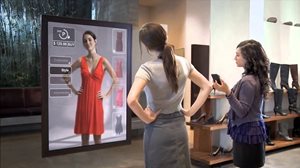7 Emerging eCommerce Technology Innovations
In my first post about the e-commerce space, I dove into the stats and the key findings from researchers that justify how far the industry has come. However, in the grand scheme of the digital universe, the industry still has a long way to go. That’s why leaders in commerce push the boundaries by testing new growth initiatives, implementing new technologies, and improving shopper engagement.
As we all know, success comes through knowing your market opportunities and potential points of friction, so let’s delve into the pieces of the puzzle that every business in e-commerce will need to address to achieve outstanding growth online and in-store.
Digitizing the Storefront
One of the most common roadblocks that online retailers haven’t completely overcome yet is the fact that people still enjoy the experience of shopping at a physical store. Although the research by Forrester predicts that online retail sales will reach $370 billion by 2017, brick-and-mortar is still a dominant player despite the power of smartphones, tablets and the increased investment in online sales by traditional retailers. But, how will new innovations help the e-commerce world become more appealing to consumers? The solution comes in the form of offline and online merging. Ebay, ModCloth, Walmart, and Delta Airlines, for example, have all experimented with pop-up storefronts to use brick-and-mortar opportunities to advocate for their digital experiences.
 Implementations of technologies can bring convenience, ease of use, personalization, process simplification, and the high level of comfort that could be a game-changer. Big brands have started to use “memory” mirror technologies led by RFID tags to let customers try on virtual outfits and place iPads in fitting rooms enabling customers to ask for help, read reviews, see what sizes are in stock, and so on. As a real-world example, American fashion brand Rebecca Minkoff has partnered with Magento to create a smart dressing room to provide customers, who create a profile with their phone number, a fully-tailored experience that recognizes the items that were tried on in the dressing room, which ones were purchased and which ones were left behind. The store can then send updates to the client to notify them that what they tried on is now available in their size or color. These, while impressive, are only the basics as many more customization options are available on the platform. In other words, the system is like “cookies” in your web browser that follow you around in the real-world. Nope, it is not a scene from a sci-fi movie. Welcome to the dawn of “In-Store Digital”!
Implementations of technologies can bring convenience, ease of use, personalization, process simplification, and the high level of comfort that could be a game-changer. Big brands have started to use “memory” mirror technologies led by RFID tags to let customers try on virtual outfits and place iPads in fitting rooms enabling customers to ask for help, read reviews, see what sizes are in stock, and so on. As a real-world example, American fashion brand Rebecca Minkoff has partnered with Magento to create a smart dressing room to provide customers, who create a profile with their phone number, a fully-tailored experience that recognizes the items that were tried on in the dressing room, which ones were purchased and which ones were left behind. The store can then send updates to the client to notify them that what they tried on is now available in their size or color. These, while impressive, are only the basics as many more customization options are available on the platform. In other words, the system is like “cookies” in your web browser that follow you around in the real-world. Nope, it is not a scene from a sci-fi movie. Welcome to the dawn of “In-Store Digital”!
Kady Thomason of Rock & Republic Clothing sees virtual try-on technology as the future of shopping, online and in stores: “Being able to see yourself, 360 degrees, wearing something where fit is crucial, like pants, glasses, a fitted blazer–that’s going to change the shopping game forever, online and in-store. There will be a major reduction in returns because shoppers will be able to accurately identify the size and color product they’ll want. It’s helping the consumer get exactly what they want. It’s exciting to see how this juxtaposition of fashion and tech will evolve.”
Data Integration
I would like to stress the importance and impact of data integration for retailers with an example that explains how Aldo took new technology to build necessary bridges between legacy and more modern systems.
 Lance Martel, Vice President and CIO at Aldo Group, a global chain of shoe and accessory stores, shifted his focus to building out a new e-commerce platform that would effectively, meld in-store and online shopping experiences. On the front end, the platform uses Hybris, SAP’s e-commerce solution that enables organizations to deliver convenient, contextual, and relevant shopping experiences by personalizing each customer's needs, while the back-end system is IBM Sterling Order Management, software that keeps tabs on inventory and order fulfillment. As a whole, they both connect to Aldo's existing systems. "We realized the need for a data integration product between those products and our legacy system, like our core merchandising and warehouse system," he said. Although the brand was keeping up with the digital transformation, using a handful of small applications wasn’t a type of integration Aldo wanted to implement on a global level. At this point, Martel and his team decided to experiment with a new integrator on the block: Redwood City-California based open source integration software provider Talend. According to what the software company stated, with using Talend, Aldo was able to integrate more than 100 applications, services, and databases, processing millions of events per day. Additionally, the platform provides enough flexibility to support integration with the RESTful APIs commonly used by websites, mobile applications and social networking sites, as well as with flat file integrations.
Lance Martel, Vice President and CIO at Aldo Group, a global chain of shoe and accessory stores, shifted his focus to building out a new e-commerce platform that would effectively, meld in-store and online shopping experiences. On the front end, the platform uses Hybris, SAP’s e-commerce solution that enables organizations to deliver convenient, contextual, and relevant shopping experiences by personalizing each customer's needs, while the back-end system is IBM Sterling Order Management, software that keeps tabs on inventory and order fulfillment. As a whole, they both connect to Aldo's existing systems. "We realized the need for a data integration product between those products and our legacy system, like our core merchandising and warehouse system," he said. Although the brand was keeping up with the digital transformation, using a handful of small applications wasn’t a type of integration Aldo wanted to implement on a global level. At this point, Martel and his team decided to experiment with a new integrator on the block: Redwood City-California based open source integration software provider Talend. According to what the software company stated, with using Talend, Aldo was able to integrate more than 100 applications, services, and databases, processing millions of events per day. Additionally, the platform provides enough flexibility to support integration with the RESTful APIs commonly used by websites, mobile applications and social networking sites, as well as with flat file integrations.
As a result, in a few months, Aldo already started to receive immediate ROI as it saw the largest Black Friday and Cyber Monday in its e-commerce sales history. According to Lance Martel, the general growth of e-commerce, mobile and in-store technologies were all powered by this data integration technology.
Chatbot
Chatbots aren’t new, yet one of the earliest chatbots, ELIZA, was published in 1966 by tapping into the same pattern-matching foundation with many modern chatbots. What’s new however, is that there’s been plenty of progress in getting chatbots up to speed in processing and responding to contextual awareness, thanks to big data and machine learning. This technology is designed to help businesses maintain the feeling of connection as well as eliminate wait times, dropped calls, and lost tempers. After all, e-commerce should be driving your customer experience.
As more companies invest in strong AI systems, such as neural nets, deep learning, and real-world human trainers, chatbots become a real digital disruption that could shake up major industries and consumer interactions.
Here is the summary of some advantages of chatbots mentioned in a Forbes article by Daniel Newman:
-
Scalable customer service - human interaction only when necessary
-
Improved customer intelligence and increased competition amongst businesses
-
Different navigational experience - conversation-based interface to find information, less text-based searching
-
Personalization - more like interacting with a good friend than a business
"It's technology that's inevitable," Microsoft's CEO Satya Nadella has said and referred to the development of chatbots as a way to create “conversation as a platform.”
Slack recently launched an external API for developers, which Taco Bell has already publicized with its in-the-works ‘Tacobot‘, apparently capable of taking your order and doing so with ‘personality’; whether consumers relate it to the same ‘brand’ of personality will be one of many areas for exploration by businesses.
Voice-activated Assistants
Holger Luedorf, SVP Business at Postmates, believes voice is a potentially powerful game changer, and he seems to be right as voice-activated assistants are picking up speed. Many also believe this technology will intersect and become one with chatbots/virtual assistants at some point in the future.
Amazon’s Echo Alexa, which represents the beacon of today’s smart home, allows consumers to order the ‘usual’ pizza or purchase more Tide dish detergent from a local delivery company. This IoT-connected, voice-activated, convenient and efficient household assistant is capable of ‘doing’ commerce with a simple vocal command and turning off lights to save energy at the same time.
Although the technology has been rapidly emerging in the US, China’s voice-powered mobile app WeChat has taken off to the tune of 700 million active users every month. The platform can hail a taxi, order takeout, buy movie tickets, and even customize a retail purchase according to your needs. Over 10 million businesses in China have WeChat accounts.
Beacon Technology
 Companies have started to offer mobile deals and greetings when someone walks into the store through beacon technology which works when consumers’ mobile devices keep searching for a beacon. Physical stores can implement physical beacons in the shops, so once someone walks in, their phone accepts the signal and provides something like a promotion. Marketers can configure their apps to activate messages as soon as certain conditions are met. If the user, for example, is within the beacon range for 3 seconds or 3 seconds after the user has left the beacon range, a marketing message can be triggered. Retailers like Sephora utilize beacon technology, which sends personalized promotions to users’ mobile device while simultaneously collecting consumer data. The beauty chain also has rolled out immersive apps that allow users to virtually try on products.
Companies have started to offer mobile deals and greetings when someone walks into the store through beacon technology which works when consumers’ mobile devices keep searching for a beacon. Physical stores can implement physical beacons in the shops, so once someone walks in, their phone accepts the signal and provides something like a promotion. Marketers can configure their apps to activate messages as soon as certain conditions are met. If the user, for example, is within the beacon range for 3 seconds or 3 seconds after the user has left the beacon range, a marketing message can be triggered. Retailers like Sephora utilize beacon technology, which sends personalized promotions to users’ mobile device while simultaneously collecting consumer data. The beauty chain also has rolled out immersive apps that allow users to virtually try on products.
Beacons are truly versatile and have found wide-scale implementation from airports to retail stores to restaurants delivering marketing offers and product information. Other brands featuring beacons for marketing include Starbucks, Macy’s, Target, and Coco-Cola.
Direct Purchase through Social Media
More and more “direct purchase” options are popping up on social media platforms like Twitter, Pinterest, Instagram, and Facebook. In fact, Facebook is the source of 64% of social sales worldwide, while 93% of Pinterest users have bought something online in the last 6 months. Moreover, the medium is the source of 16% of all social sales as Pinterest’s rich pins functionality enables retailers to fully integrate their site, automatically synchronizing any change on the product’s page with the product’s “pin”. Clicking on the pin automatically takes the shopper to the product page, optimized to convert this prospect into a sale. J.Crew, GAP, and Nordstrom are only a few of the American retailers that quickly capitalized on this new trend.
On Instagram, integrated applications now make it possible to go from an Instagram picture directly to a product page. It drives even more traffic to a retailer's website when celebrities and/or influencers promote products.
Industry Analyst Scott Liewehr, CMS-Connected Host Tyler Pyburn, and President at commercetools US Arthur Lawida also discussed “direct purchase” options on social media and a CMS first approach in e-commerce on the most recent featured topic segment of the CMS-Connected Show:
Video Content
Many businesses are now taking things to the next level with branded, custom video content as it can boost a retailers’ site SEO, increase conversions, make content more shareable, build a lot of trust with prospective customers, and help shoppers consume more information in less time. Behind-the-scenes production videos, demonstrations, 360-degree product rotations and even live streaming are now being looked at as viable strategies. Especially, product videos which tell an engaging story can revolutionize any brand. Here’s a great example that shows how a successful video content strategy leads a start-up e-commerce company to make $1 billion in less than five years.
In 2012, Michael Dubin launched an online men's razor merchant, Dollar Shave Club, with a hilarious YouTube video making fun of the pain and expense of shaving. The video went viral, the website crashed, and the blades sold out in six hours. Guess what? Two weeks ago, Dollar Shave Club hit the jackpot as Unilever agreed to buy the online men's razor merchant for $1 billion which is about five times the revenue that Dollar Shave Club is expected to bring in this year.
Ryan Darnell, Principal at Basset Investment Group, which invests in such e-commerce startups as luggage seller Raden, commented: “Unilever and P&G are masters at traditional marketing, mostly offline, but they struggle with the direct-to-consumer brand-building at which upstarts like Dollar Shave Club excel. These startups conduct authentic-seeming conversation with customers over social media, while the consumer products conglomerate take to Twitter and Facebook mostly to address customer complaints.”
Another unique example is the “beyond the product” campaign executed by a furniture retailer Structube to generate brand awareness and interest. The video-based campaign published 10 episodes on the people and stories who build the products. The campaign succeeded not only because of strong, beautiful images and smart, artful editing but also an engaging storytelling method which almost feels like a human guided tour of a world many aren’t familiar with. The brand also combines the campaign with a contextually driven lookbook that allows customers to shop by style and interest.
These are really just the starting point as we will be seeing fascinating changes and outside-the-box thinking in the e-commerce technology space in the coming years. Throughout this period, some technologies like mobile-first will become a mainstream, while some advances like drones may disappear in the near future. Regardless, investing in these and other emerging technologies is undoubtedly a smart move when it comes to positioning a business that remains with or ahead of the curve over the next 5 to 10 years.

Venus Tamturk
Venus is the Media Reporter for CMS-Connected, with one of her tasks to write thorough articles by creating the most up-to-date and engaging content using B2B digital marketing. She enjoys increasing brand equity and conversion through the strategic use of social media channels and integrated media marketing plans.